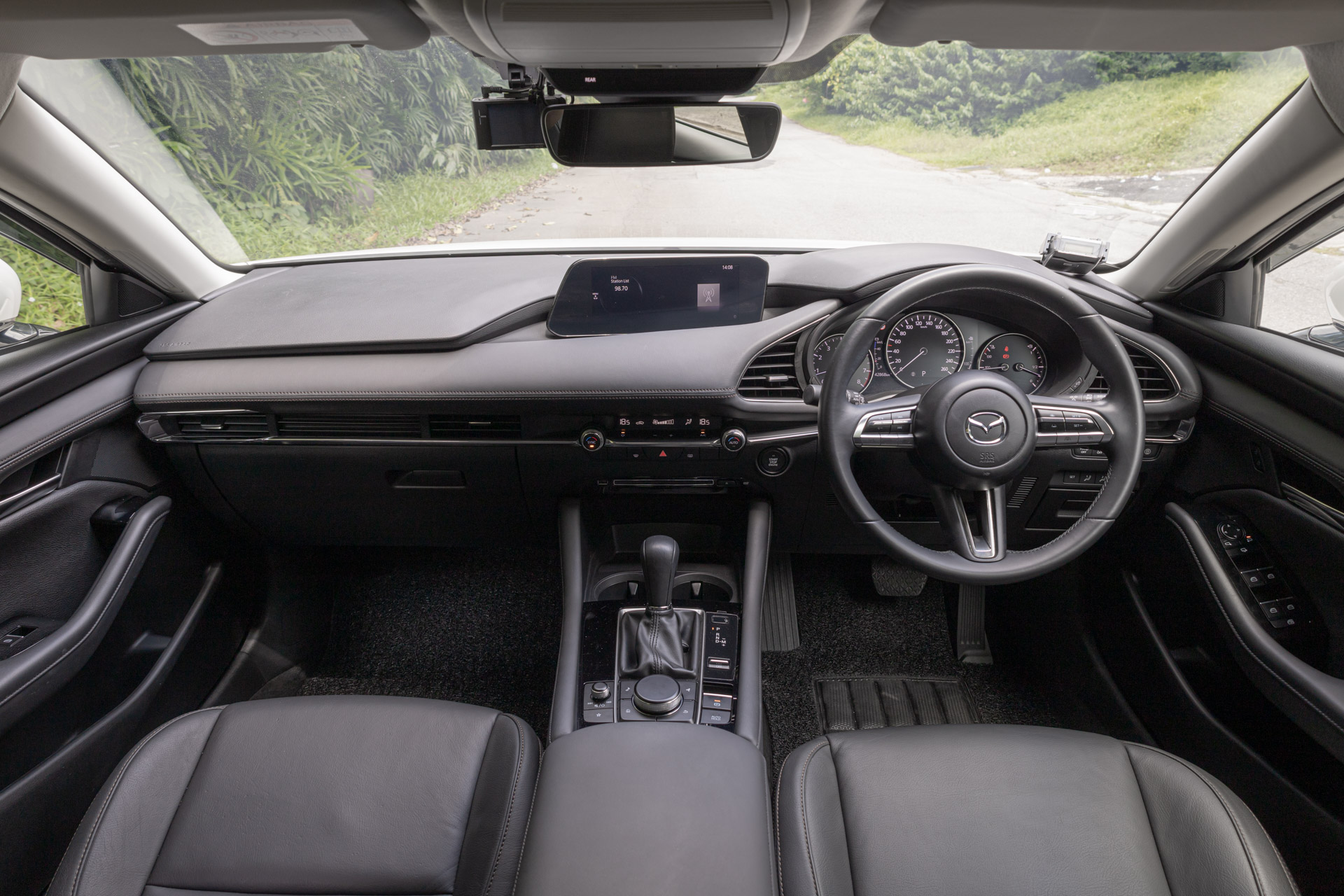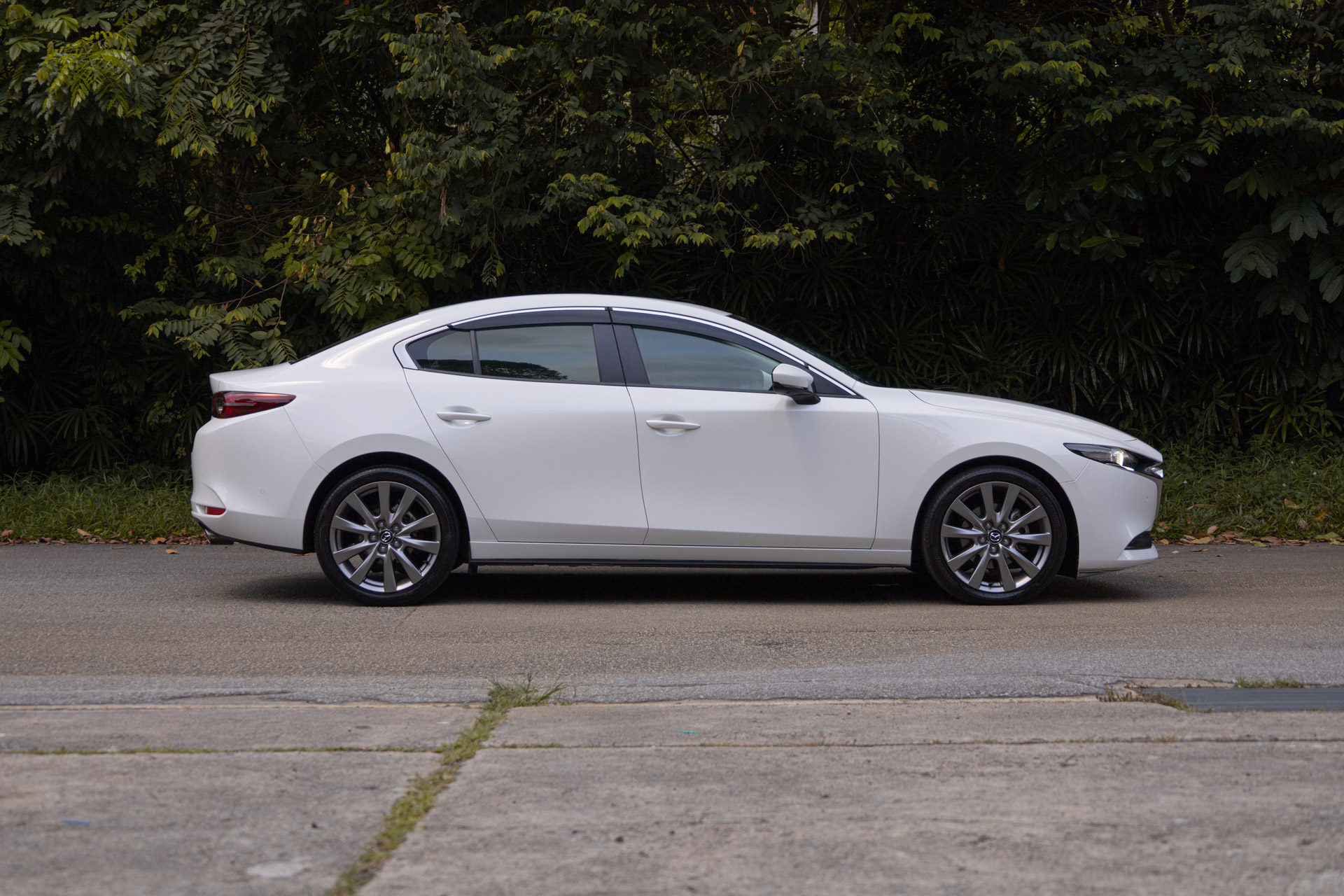Motorist Car Buyer's Guide: Mazda 3 Mild Hybrid 1.5A Elegance

The Mazda 3 has seen many an iteration. Introduced in 2003, it has been a constant presence on local roads ever since. It wasn’t exactly known for being the best looking car, but with the current generation, one could definitely agree that the Mazda 3 has experienced a “glow up”.
If anyone can think back far enough, the Mazda 3’s predecessor, the Mazda 323, was a common sight (also utilised as police cars, with some still being in use today). The third generation model was used extensively for private hire duty, on top of being very popular with private owners too.
In my opinion, the design for the first two generations were more evolution than revolution, but that changed from the third generation onwards, which was almost completely different. But with the fourth generation, I feel that Mazda has again reverted back to a more evolutionary style with the fourth generation while still adhering to the “Kodo Design” ethos. Whatever your opinion on the aesthetics, it seems to be working because the Mazda 3 popularity hasn’t dwindled.
Motorist would like to extend our thanks to One Drive Automobile for loaning us the Mazda 3 for this article.
What is this?

As mentioned earlier, this is the fourth generation Mazda 3, specifically a 2020 Mazda 3 Mild Hybrid 1.5A Elegance, which is the mid-range option in Singapore. While the Mazda 3 is available in foreign markets with 1.8, 2.0 and 2.5-litre engines in petrol or diesel forms, Singapore only received the 1.5-litre naturally aspirated mild hybrid petrol version.
This is somewhat unfortunate (and a little boring), because the 2.0-litre engine is Mazda’s new Skyactiv-X engine, with an even higher compression ratio ranging from 15:1 to 16.3:1. Yes, an engine with a higher compression ratio than the Ferrari 458 Speciale, which was 14:1. But given our taxes and high car prices, it's understandable why the Mazda 3 was fitted with a 1.5-litre engine for Singapore.

But, it’s not all a bad thing. Yes, the 1.5-litre Skyactiv-G engine might only produce 120 horsepower and 153 Nm of torque, but it is pretty much the same engine carried over from the third generation model, which has been known to be pretty reliable. Power is sent to the front wheels via a six-speed torque convertor automatic. Fun fact, Mazda is the only Japanese manufacturer who has not fitted their cars with CVTs, preferring a torque converter automatic for its smoother characteristics.
And if you’re wondering about the mild hybrid system, it doesn’t contribute much to the engine’s power. Instead, the 5.1kW battery is there primarily to fill in the torque during initial acceleration, and also to power the electronics.
Is it any good on the wallet?

Being Japanese, the Mazda 3 is well known for its reliability, with hardly any mechanical problems. There is a reason why so many of the previous generation Mazda 3s were running around for private hire duty, they were mechanically reliable and easy to work on. With proper maintenance, which means a basic service every 10,000km or six months, with a major service every 40,000km, the Mazda 3 is a reliable workhorse for all your needs and more.
Fuel economy is pretty good, as expected for a small engine, and with a mild hybrid system fitted too. With a 50 litre tank, one can expect between 650 kilometres to 850 kilometres on full tank, or 13 to 17km/litre, which are very good numbers considering it is on a mild hybrid system. Of course, these numbers would depend on your driving style, but overall, the Mazda 3 is still pretty fuel efficient.
Still, there are some known issues with the Mazda 3. While the third generation either had a fully analogue gauge cluster or an analogue tachometer with small digital screens on both sides, depending on the specification, the current generation has switched over to a fully digital gauge cluster. This fully digital gauge cluster has been known to have issues with dead pixels, with the only fix being to replace the entire gauge cluster. Fortunately, the gauge cluster can be replaced under warranty.

Also, the Mazda 3 has a rather complex suite of electronics, which can cause the battery to drain a little faster than usual. Even something as simple as leaving the door open for an extended period of time has been known to drain the battery. Quite a few owners have also reported their batteries going flat in less than 2 years. While this isn’t a crippling issue, it is worthwhile to take note of because there is nothing more irritating or inconvenient than a flat battery.
So yes, the Mazda 3 is a reliable car, but never rest on your laurels, and should you be interested in buying one, do send it for a pre-purchase inspection. Who knows, the money you spend on that pre-purchase inspection could potentially save you a large sum down the road.
Is it comfortable inside?

Very much so. The Mazda 3 has taken a huge step up in terms of comfort and refinement, with the interior having the fit, finish and feel of a continental brand for a much lower price. For a car with a rear torsion beam setup, the ride quality is befitting a car in a much higher price bracket. The factory sound insulation also does a good job of damping most road noises, and is not something that I expected out of a car that is targeted at the masses.
While the interior is all black, it does match the white paint job of this particular unit. Most of the interior is covered in smooth synthetic leather, with touch points like the dashboard, arm rest, door cards, steering wheel and gear knob being soft to the touch as well. The driver’s seat is electronically adjustable, with ample headroom for all passengers, even at the rear. Still, given the proportions of the Mazda 3, it would be more comfortable to carry four passengers instead of five.
The infotainment system is factory fitted, and it is simple and intuitive to use, and is 8.8 inches in size. Android Auto and Apple Carplay are available, but must be connected via a cable. The only possible gripe would be that the screen can be a little far from the driver, which could make it difficult to see what is on the screen while driving. Thankfully, Mazda fitted physical controls to the infotainment system, with a rotary dial for functionality control, including another rotary dial for volume control.
The HVAC controls are also physical knobs, which makes adjusting the air-conditioning easy even when on the move. Being a Japanese car, the air-conditioning blows really cold, which is extremely welcome in Singapore’s climate. The front air-conditioning has dual zone functionality, which allows the driver and passenger to set the temperature to their liking. Unfortunately, there are no air-conditioning vents at the rear.
The steering column has both tilt and telescopic adjustment, and as mentioned earlier, the gauge cluster is fully digital. The rear seats can be folded down in a 60/40, with the levers to put the seats down located in the boot. The ISOFIX points are easily accessible, being located under plastic covers.

The Mazda 3 comes factory fitted with Bridgestone Turanza T005A tyres in the size of 215/45/R18, which are comfortable and quiet. They are not performance tyres, so keep that in mind if you want to go around a corner spiritedly.
For a car in this segment and price point, the Mazda 3 comes as standard with quite a few safety systems, which is quite uncommon. The safety assists include adaptive cruise control, lane departure warning, plus front and rear cross traffic warning. Additionally, the in-car camera will also read speed limit signs on the road and display the speed limit on the gauge cluster and heads-up display. While you can opt not to use these safety assists, or turn them off, it is still a useful function to have, especially when driving in heavy traffic or when you are tired.
Can it carry a lot of cargo?
The boot space in the Mazda 3 is decent, with 444 litres of boot capacity with the seats up, and 859 litres when the rear seats are down. Not the most generous in terms of boot capacity, but it is more than sufficient for most people.
Interestingly, there is a spare tyre, albeit a space saver tyre. This feature is getting increasingly rare in new cars nowadays, and is a much better option to have rather than the tyre foam that most manufacturers put in new cars today, as the foam doesn’t exactly work as it should most of the time.
Alternatives

If you want another Japanese option, it's hard to go wrong with the Toyota Altis. Toyota is legendary for its reliability, with their new cars today having it too. Like the Mazda 3, the new Altis is also a huge step up from the previous generation in terms of refinement, build quality and ride comfort. However, it comes with a CVT, instead of a torque convertor automatic, and unlike the Mazda 3 which is built in Japan, the Altis is built in Thailand.

Should you want something not Japanese, then how about the Hyundai Avante? My colleague tested one, and he really enjoyed it. Yes, it also has a CVT, but being a Korean car, you get a lot more value for your money, given how the Korean manufacturers are known to include a lot more features as standard equipment compared to Japanese manufacturers.
Verdict
It's hard to go wrong with the Mazda 3. Reliable, comfortable, generous in features, and not to mention a design which is, in my opinion, one of the most striking designs in the automotive world today.
It is far from the most powerful vehicle, but with the amount of engineering Mazda has done in building this car, you are still guaranteed a fine-handling car with ride comfort to match, which today, is almost unheard of in this price point or segment. It isn't the cheapest car either, but the Mazda 3 is a car you will turn back to look at as you walk away, just to appreciate its looks once more, up until your next drive in it.
If you are keen on getting a Mazda 3 as your next car, or any other used car for that matter, do take a look at our used car selection here for some of the best deals!
Motorist would like to again extend our thanks to One Drive Automobile for loaning us the Mazda 3 for this article.
Photo Credits: Lee Thern Yang (@TheBigSoup)
Read More: Motorist Car Buyer's Guide: Volkswagen Passat 1.8 TFSI
Download the Motorist App now. Designed by drivers for drivers, this all-in-one app lets you receive the latest traffic updates, gives you access to live traffic cameras, and helps you manage LTA and vehicle matters.
